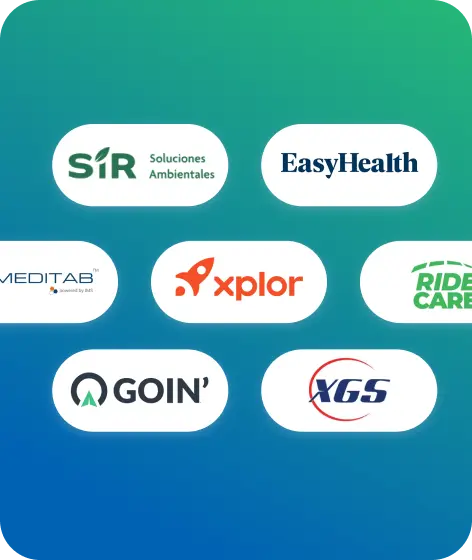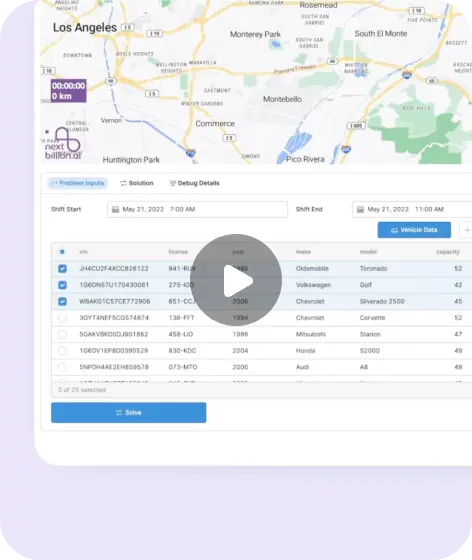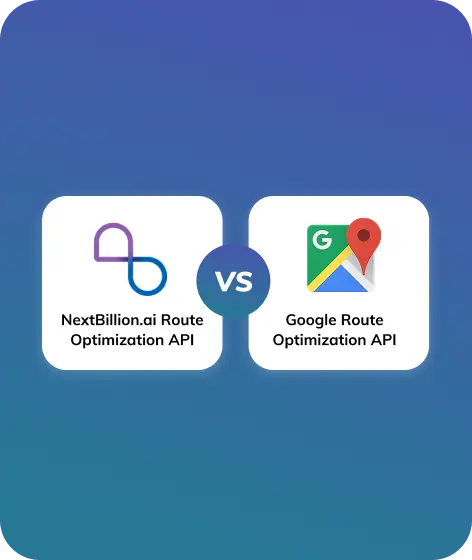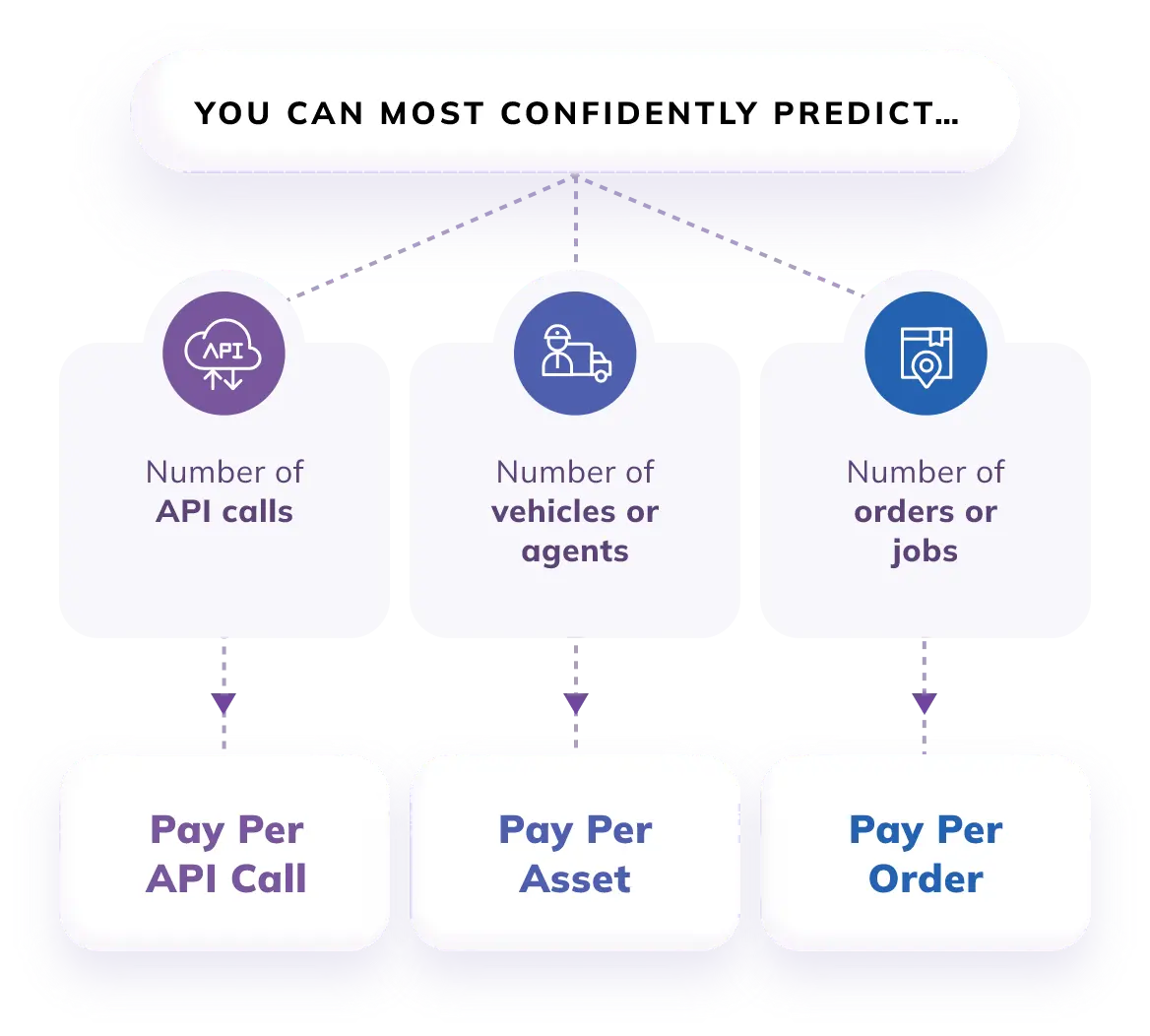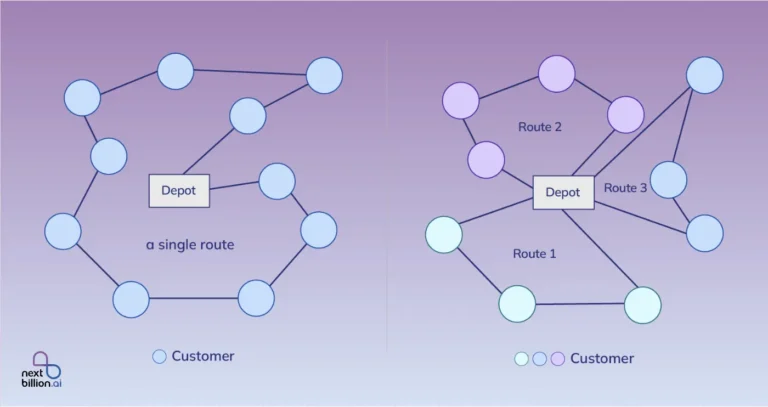
Table of Contents
Efficient vehicle or fleet management is the backbone of modern logistics. As global supply chains grow increasingly complex, businesses face challenges associated with delivering faster products and services, reducing costs, and enhancing customer satisfaction. Logistics costs are also increasing due to a confluence of factors. Broader economic influences, such as inflation, are making their mark on the transportation and delivery industry.
Rising fuel prices and wage increases have led to a significant increase in transportation costs, while the cost of raw materials and packaging also continues to soar. Route optimization is the best strategy that helps in reducing logistics costs in 2025, saving time and improving workforce productivity. In this blog, let’s learn how route optimization can lower logistics costs and streamline operations.
The Rising Logistics Costs in 2025

Logistics costs are expenses related to demands for the movement of different products and services in a business’s supply chain. 2025 is going to be a challenging year for eCommerce businesses and logistics providers. This year, direct logistics costs are expected to increase further because of labor shortages, rising fuel prices, and supply chain challenges.
Labor shortages, especially in areas like warehouse workers and drivers, will push wages higher and raise overall logistics expenses. Automation can help get rid of these additional expenses, but it also requires significant upfront investment. Here’s an overview:
Factors Driving Up Logistics Expenses
Since there are multiple factors to consider when deciding any other vehicle rates, determining logistics costs is not that simple. Currently, four major factors heavily influence the cost of the logistics industry. They are:
1. Operating Costs
The cost of operating any vehicle can vary depending on both fixed and variable costs. The fixed cost must be incurred by the vehicle owner, regardless of whether it’s in motion or not. Examples of fixed costs are financing and depreciation, insurance, tolls, permits, and taxes.
Conversely, the variable cost is subjective when the vehicle is on the road. Examples of variable costs are vehicle maintenance, driver wages and benefits, and fuel expenses.
2. Number of People in the Logistics Chain
The number of people in the loop often determines the price of moving goods or logistics from one location to another. These people are the load owner, the transporter, middlemen or brokers, and the vehicle owners.
3. Supply and Demand
The types of vehicles in the place and their availability are also accounted for when calculating logistics costs. Depending upon the product transported, the same vehicle should be capable of handling the product because the cost fluctuates according to it. Meanwhile, a shortage of skilled labour or increased wages results in higher costs for activities such as unloading, loading, and warehouse operations.
4. Seasonal Demand
Seasonal factors have a significant impact on logistics costs worldwide. Many countries have a wide range of climatic conditions and experience all seasons accordingly. As the seasons change, so do the fluctuations and challenges in logistics operations, which impact costs.
5. The Impact of Businesses and Supply Chains
Businesses and supply chains impact logistics costs through factors like inventory management, transportation efficiency, and supplier relationships. Poor inventory control can lead to excess storage costs or stockouts.
Conversely, inefficient transportation routes increase fuel and labor expenses. Companies with streamlined supply chain processes can easily reduce logistics costs by minimizing waste and improving operational efficiency. For instance, any organization leveraging just-in-time (JIT) inventory and optimized distribution networks often witnesses fewer logistics costs.
Supply chain disruptions can drive up costs due to expedited shipping needs and increased demand volatility. Common examples include delays from suppliers or geopolitical issues. Effective coordination between manufacturers, suppliers, and distributors helps get rid of such risks for cost-effective logistics operations.
Route Optimization as a Solution to Rising Costs

Reducing logistics costs in 2025 becomes easier with route optimization. It is an excellent strategy that directly translates to cost savings in logistics by minimizing travel distances, fuel consumption, and delivery times. Businesses can create highly efficient routes that avoid traffic, road closures, and other delays with AI-based logistics and advanced software logistic solutions.
What is Route Optimization?
Route optimization in logistics refers to a process of planning the fastest and most cost-effective ways for mobile field service workers like drivers or agents to get from one location to another. Route optimization ensures that your mobile workforce spends less time driving to boost their efficiency and support sustainability.
It is the process of determining the most cost-efficient route and ensuring factors like traffic conditions, distance, delivery time windows, and fuel consumption are optimized.
How Does it Reduces Fuel and Operational Costs?

Operational costs are a big pain point in logistics, with labor, fuel, and vehicle maintenance being the largest contributors. AI-powered route optimization easily minimizes these expenses by:
- Reducing mileage
- Optimizing fuel usage
- Eliminating unnecessary vehicle wear and tear
For example, AI systems help several companies save on fuel costs in present times. They make this possible by optimizing last-mile delivery routes. This helps reduce backtracking and unnecessary stops.
On that note, fuel costs are one of the largest operational expenses in logistics. Route optimization helps create better delivery schedules and reduces the need for overtime work. This further limits wear and tear on vehicles.
As a result, long-term maintenance costs go down easily, with more logistics companies using route optimization software for their needs.
Enhancing Delivery Speed and Efficiency
AI-powered route optimization can easily speed up deliveries. AI systems calculate the most efficient routes by analyzing multiple real-time traffic patterns, construction delays, and relevant weather conditions. They also prioritize deliveries based on service agreements or the ones demanded by customers. This ensures the most crucial shipments are delivered first.
This real-time adaptability offered by route optimization helps drivers spend less time in traffic. They can easily avoid backtracking and make faster deliveries. This leads to higher output for businesses as they get happier customers and a competitive advantage.
Key Technologies Behind Route Optimization
Route optimization in logistics has transformed greatly over the years, with several technologies backing its functionalities. This has helped the logistics industry ensure faster deliveries and improved customer satisfaction. Here is an overview of these key technologies behind route optimization:
AI and Machine Learning for Smarter Routing

AI-powered and Machine Learning algorithms allow more accurate predictions in route optimization. These technologies also assist with adaptive routing, fuel cost reduction strategies, and proactive decision-making based on historical trends and real-time data.
AI-powered route optimization, on the other hand, examines real-time traffic data. These systems often integrate AI and ML to collect and process data from traffic cameras, GPS devices, and mobile apps. Route optimization algorithms easily adjust routes based on real-time traffic conditions. This reduces the travel distance and time and minimizes congestion.
GPS and Real-time Traffic Data Ingestion

Real-time traffic data helps drivers or agents select the most efficient routes. The reduction in idle time also leads to notable fuel savings in the long run. Every minute counts in delivery and logistics, so fleet route planning with the latest traffic updates ensures that drivers can easily avoid delays.
Route optimization solutions often integrate geographic information systems (GIS) and GPS data for efficient delivery processes. This involves incorporating real-time traffic data to allow dispatchers to adjust routes on-the-fly based on changing conditions, such as weather conditions or accidents.
Predictive Analytics for Demand-based Routing
Predictive analytics in demand-based routing helps anticipate all kinds of future developments by drawing on historical and actual data. The predictive approach often makes it easier for logistics firms to incorporate various changes. This helps them control the inventory and diminish the risk of stock outs and overstocking easily.
Case Study: How Does a Trucking Logistics Solution Provider Reduce their Costs by 30%?
Logistics management is the key to success for businesses that depend on logistics and deliveries. Rising fuel prices, unpredictable traffic conditions, and increasing customer demands have pushed companies to search for more cost-effective solutions. A US-based startup provides AI-driven trucking logistics solutions to enhance fleet operations. The company operates in the United States, Canada, and Mexico and has over 60 trucks in its fleet.
The company had been using distance matrix API to calculate the distances and estimated time of arrivals. However, there were two major problems:
- Increased logistics costs due to heavy and frequent use of API
- Inflexible pricing models
This made the client hunt for a new feasible and reliable solution which met the following criteria: cost-efficiency, cost predictability, scalability, and high API response time. They partnered with NextBillion.ai, and here’s how our solution helped them overcome the challenges:
- Most APIs offer industry-standard 25×25 matrix size, but NextBillion.ai’s distance matrix supports 5000×5000 elements. This helped them to calculate ETAs and distances between 5000 origins and 5000 destinations within a single call with high accuracy.
- A customizable pricing model was built to match their unexpected volume of API calls. Using an asset-based pricing model, the company was able to predict the costs on the basis of how many trucks would be utilized every month.
The company gained more control over their expenses with a predictable and sustainable cost structure. They were able to reduce their costs by 30%. Read the case study in detail to see how NextBillion.ai’s suite of dynamic route planning APIs and SDKs helped them achieve more.
Best Practices for Implementing Route Optimization in Logistics
Route optimization software plays a key role in modern logistics. These tools analyze various factors, such as traffic patterns, delivery windows, and vehicle capacity, to generate the most efficient routes.
This optimization also leads to significant cost savings by minimizing wear and tear on vehicles and reducing fuel consumption. Companies that use route optimization software often see a marked improvement in their operational efficiency. This easily allows them to handle more deliveries with the same resources.
Using Real-time Data for Dynamic Adjustments
Route optimization software can easily make real-time adjustments. Unexpected events like road closures, traffic jams, or sudden changes in delivery schedules can be managed easily with active assistance from these tools or solutions.
Dynamic routing also ensures that drivers or agents are always on the most efficient path. This further assists the logistics businesses in reducing delays and improving cost efficiency. This adaptability is key to success in today’s unpredictable logistics environment, where timely deliveries guarantee customer satisfaction and encourage repeated business.
Optimizing Vehicle Load and Delivery Scheduling
Efficient vehicle load management and well-structured delivery scheduling are critical aspects of route optimization. By ensuring that each vehicle is loaded to its optimal capacity and that deliveries are planned strategically, logistics businesses can significantly reduce operational costs and improve overall efficiency. Here’s what companies can do to reduce vehicle load and ensure prompt delivery scheduling.
Smart Load Distribution
Advanced route optimization systems use AI and data analytics to distribute load capacity intelligently. These systems consider factors such as vehicle size, weight limits, package fragility, and delivery sequence.
Proper load balancing prevents underutilization of space, reducing the number of trips required and minimizing fuel consumption. Businesses can also ensure that heavier and frequently delivered items are placed in accessible areas of the vehicle to improve unloading efficiency.
Efficient Delivery Scheduling
AI-driven route optimization tools analyze delivery time windows, traffic conditions, and customer preferences to create an optimized schedule. This prevents overlapping delivery routes, minimizes idle time, and ensures that drivers complete their tasks within the shortest time possible.
Businesses can also prioritize high-value or time-sensitive shipments to ensure they reach their destination promptly.
Minimizing Empty Miles
One of the biggest inefficiencies in logistics is empty miles when vehicles travel without carrying goods. Optimized delivery scheduling helps businesses plan return trips more effectively. This involves actively aligning incoming shipments with outgoing deliveries. It cuts down fuel expenses significantly, reduces vehicle wear and tear, and contributes to sustainable operations.
Improved Customer Satisfaction
When deliveries are well-organized, customers receive their shipments on time. This is how logistics businesses easily enhance the overall experience of their long-time users. Real-time tracking and accurate ETAs, enabled by smart scheduling, keep customers informed and reduce complaints related to late or missed deliveries.
Integrating Route Optimization with Fleet Management Software
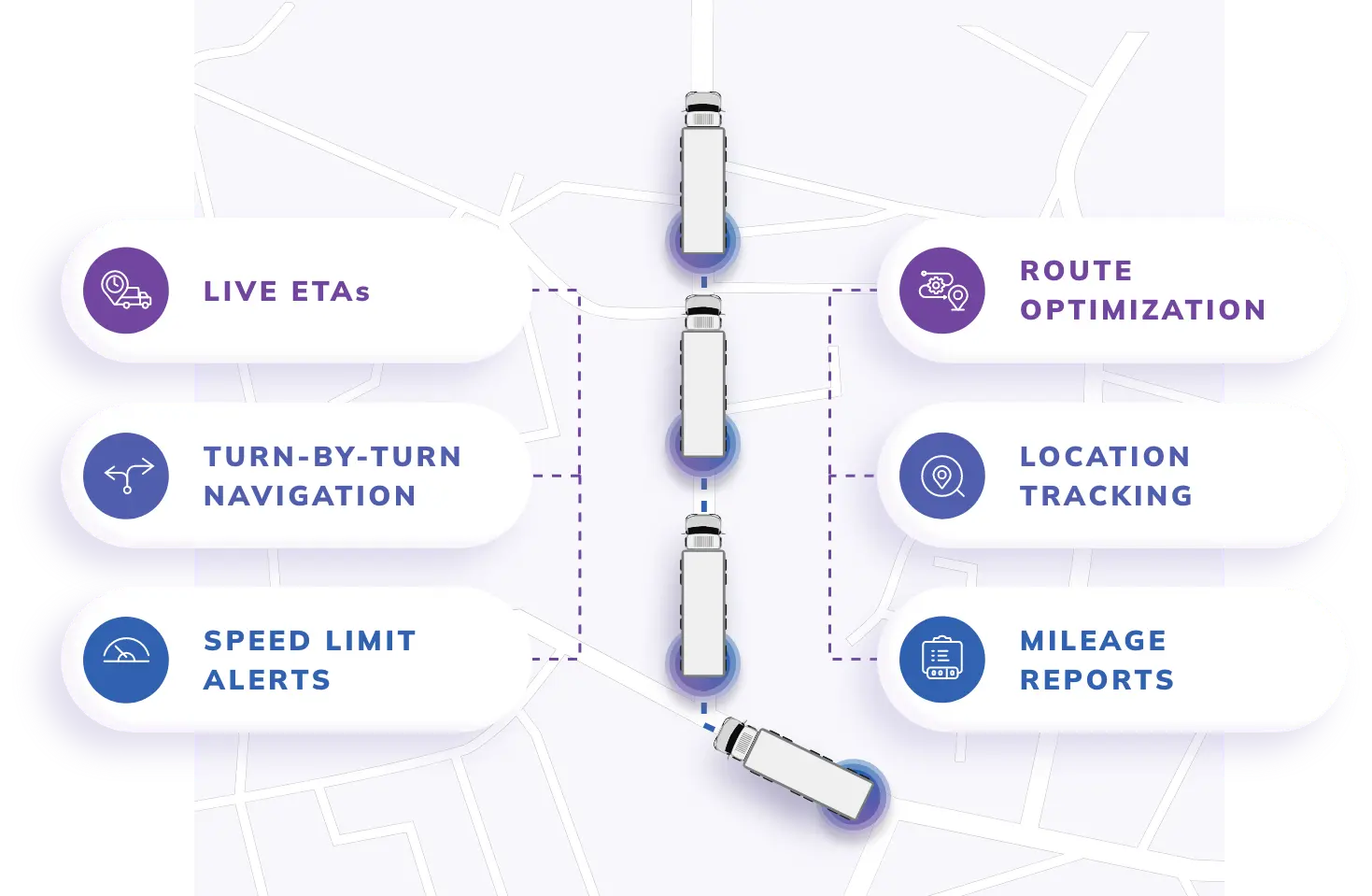
The process of integrating fleet management software with route optimization in logistics involves connecting multiple software applications to improve operational visibility, workflow efficiency, and data accuracy.
The software programs used by fleet operations capture and use the required information, and the purpose of the integration is to bring everything together into a single system. This particular software often serves as a conduit for either retrieving or posting information to ensure fleet management efficiency.
Integrations with logistics route planning and optimization software allow the most efficient routes to be pushed into a particular fleet management platform where job management tools, proof of delivery and GPS routing can be used. Route compliance data and proof of delivery details are also incorporated into the route optimization software to enable the plan vs actual analysis. Here are the steps to follow when integrating route optimization with fleet management software:
Step 1: Identify Business Needs and Goals
You must first identify the business needs and goals that the solution should address before starting the integration process. Make sure to enter the process without any preconceived notions, regardless of whether you have used any other similar systems earlier. Work with your software provider by discussing your desired outcomes. This allows you to work backwards from there and into multiple customized solutions.
Step 2: Determine Integration Capabilities
Once your logistics and transportation needs and goals have been identified, work with your software provider to determine the specifics of the integrations. They must understand how the software best fits with your existing business operations to enable a connected environment. This also involves analyzing what pieces of your business must be optimized and the types of data to be exchanged forth and back into systems.
Step 3: Plan and Prepare an Integration Strategy
Once all integrations between route optimization and fleet management software have been accounted for, you must plan your integration strategy. Decide on the timing of integrations and the logistics of data transfers and preparation. Please note that this is a multi-stage process, and your data must be cleaned and standardized to ensure proper mapping and compatibility.
Step 4: Test and Troubleshoot Your Integration
Once the collected and analyzed data set is ready, test your integrations to ensure data transfers happen as expected. This involves running test scenarios and validation tests to identify any other errors or issues. You can troubleshoot any identified concerns with your provider to remediate the anomalies.
Step 5: Go Live and Monitor Performance
Once all integrations between the software and route optimization tools have been tested, you can test the service. Make sure to continue monitoring performance in the live environment to ensure all data transfers are optimal and accurate. Review the data on time and adjust integrations as needed for continued success.
Final Words
The exponential rise in eCommerce has already reshaped the logistics industry. This has led to an increased demand for faster and more cost-effective shipping solutions. As online orders and customer demands for faster deliveries continue to grow, companies need to integrate advanced technologies to optimize their supply chain efficiency and improve last-mile delivery services. NextBillion.ai’s route optimization software can help you reduce logistics costs and streamline operations.
FAQs
Route optimization directly helps minimize travel distances, fuel consumption, and delivery times. It specifically works with AI-based logistics and advanced software logistic solutions to help businesses create highly efficient routes that avoid traffic, road closures, and other potential delays.
AI algorithms, in collaboration with machine learning and route optimization, analyze various factors such as traffic patterns, weather conditions, and delivery time windows. This helps them determine the most efficient routes to reduce fuel costs, minimize delivery times, and ensure timely deliveries.
Businesses can integrate route optimization into their logistics operations by implementing AI-powered software that analyzes real-time traffic, weather conditions, and delivery schedules to determine the most efficient routes. This involves integrating GPS tracking, automated dispatch systems, and load management tools to streamline fleet operations. Companies can also use predictive analytics to anticipate delays and adjust routes dynamically.
About Author
Bhavisha Bhatia
Bhavisha Bhatia is a Computer Science graduate with a passion for writing technical blogs that make complex technical concepts engaging and easy to understand. She is intrigued by the technological developments shaping the course of the world and the beautiful nature around us.

